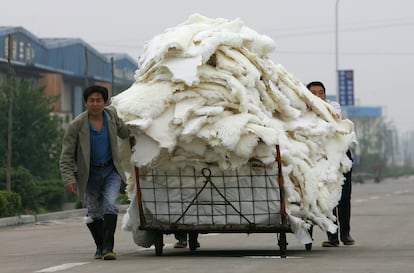Dozens of ‘high-risk’ viruses discovered on fur farms in China
Coronaviruses, influenzas and other potentially dangerous pathogens infect raccoon dogs, mink, and foxes bred for the fur trade

Nearly five years after the event, the world still does not know exactly how the coronavirus pandemic — which killed more than seven million people worldwide and was the most serious global health emergency of the 21st century — began. The clearest clues lead to an unfortunate chain of contacts between wild animals, most likely bats, and intermediate species that ended up for sale in markets in Wuhan, China.
Now, an international team of scientists offers new insights into where and how the next pandemic may be brewing. The researchers analyzed the organs of 461 animals from dozens of species raised on fur farms in China, one of Asia’s leading producers. All the animals had died for unknown reasons.
The results reveal the presence of more than 100 different viruses, many of them unknown. Among them are 39 that the authors of the research define as “high risk,” as they have the ability to jump between species and potentially to humans. The research describes several viruses from wild animals that have spread to domestic species, often raised in their thousands in overcrowded cages and without sanitary controls. Samples were collected between 2021 and 2024 in more than a dozen provinces, mainly the four major fur-producing provinces of Hebei, Shandong, Heilongjiang, and Liaoning, in the northeast of the country. The results were published on September 4 in the journal Nature.
British virologist Edward Holmes, one of the authors of the study, announced to the world the genetic sequence of the coronavirus that causes Covid-19 on January 10, 2020. Since then, Holmes has been one of the major proponents of the theory that the pandemic virus originated in bats and reached humans through other animal carriers sold in Chinese markets. “Breeding animals for fur is an obvious way in which a pandemic coronavirus, or flu virus, could emerge in humans,” Holmes tells this newspaper. The researcher, from the University of Sydney in Australia, emphasizes: “Our study shows that viruses have jumped from wild species to farm animals. Because humans are in close contact with these animals, there is also a risk of contagion, and in fact we see that some human viruses have been transmitted to animals.” Researchers have so far detected no cases of human-to-human infection.
Raccoon dogs, members of the fox family, are nocturnal carnivores that are bred by the millions on Chinese fur farms for their pelts. Another coronavirus that emerged in China in 2002 and killed nearly 800 people — severe acute respiratory syndrome (SARS) — was also detected in a Guangdong animal market in raccoon dogs. The new work points to this mammal, along with mink, guinea pigs, rabbits, and arctic foxes, as the major carriers of viruses classified as “high-risk” to humans.
Among the pathogens isolated are viruses from many families, including coronaviruses and influenza viruses. The most “worrying” of these, according to Holmes, may be the HKU5 coronavirus, which originated from the common bat and was found in mink that died of pneumonia, the British researcher notes. This pathogen is related to MERS, which has been detected in 27 countries and has killed nearly 900 people since 2012. The jump from bats to mink is “alarming,” Holmes points out, and requires monitoring.
The research is published just as the world is witnessing the worst avian flu epidemic ever recorded. A new, highly pathogenic H5N1 virus emerged in wild birds in 2021. It has since spread to domestic species, forcing the culling of hundreds of millions of birds, and infected wild and domestic mammals, especially dairy cows in the United States but also mink on fur farms in Spain. It has already spread to humans and reached Antarctica, the most isolated and pristine continent on the planet. The scientific community is holding its breath in anticipation of the possibility that, during this uncontrolled circulation, the virus could gain the ability to transmit efficiently between people, which could lead to a new pandemic.
The study published in Nature, in which several researchers from Chinese universities and the Chinese Academy of Sciences also participated, has not detected the highly pathogenic variant of the flu in farm animals, but it has detected others that have infected humans in the past and that must be monitored, warns Holmes, who adds this could be “the tip of the iceberg.” The researcher is blunt: “All fur farms should be closed. They are one of the most likely places for the start of the next pandemic. Although our study has focused on China, there are farms of this type all over the world.” Cases of contagion with Covid-19 and H5N1 flu in mink, for example, have severely affected countries such as Denmark, which was the world’s leading producer, as well as Holland and Spain among others.
During the coronavirus pandemic, the Chinese government limited access by international scientists to the markets where the contagions are suspected to have started. Despite this, a study conducted by Chinese scientists uncovered the regular marketing of live wild animals in Wuhan, and another international study demonstrated the existence of DNA from raccoon dogs and coronavirus in the same samples taken at the Huanan market in January 2020. These tests are not enough to clarify the origin of the pandemic, or to identify the first patient, but they do point to raccoon dogs as a likely intermediate host of SARS-CoV-2.
“We have reached the end of the road in terms of the origin of Covid-19″, Holmes opines. “I’m sure there will be no more data from China, where there is enormous political control, and all the animals involved are already dead. It is possible that more SARS-CoV-2 viruses will be obtained from bats in other countries that are possibly closer to the one that caused the pandemic. I am convinced that there was an intermediate host, but I am afraid we will never know exactly which one it was.” In spite of everything, the researcher says that he has not perceived any political obstacles to carrying out the current study on fur farms.
Virologist Angela Rasmussen, from the University of Saskatchewan (Canada), who was not involved in the study, emphasizes its relevance. The published data “present a clear risk of emerging viruses from contact between animals and humans on these farms,” she says. This threat remains “unsupervised,” she adds. The scientist explains that it is difficult to determine which virus is more dangerous or transmissible knowing only its genetic sequence, although she highlights coronaviruses and flus, the latter being especially threatening because they reconfigure their genome every time there is cross-species contagion, which increases the risk of generating epidemics. Rasmussen agrees that all fur farms should be shut down, although she does not see this as realistic. “The next best option is regulation of production practices, including increased surveillance of both animals and workers in these facilities, avoiding overcrowding, providing veterinary care, including humane euthanasia for sick animals, and occupational safety standards for employees to reduce the risk of exposure, such as the use of face masks,” she says.
Sign up for our weekly newsletter to get more English-language news coverage from EL PAÍS USA Edition
Tu suscripción se está usando en otro dispositivo
¿Quieres añadir otro usuario a tu suscripción?
Si continúas leyendo en este dispositivo, no se podrá leer en el otro.
FlechaTu suscripción se está usando en otro dispositivo y solo puedes acceder a EL PAÍS desde un dispositivo a la vez.
Si quieres compartir tu cuenta, cambia tu suscripción a la modalidad Premium, así podrás añadir otro usuario. Cada uno accederá con su propia cuenta de email, lo que os permitirá personalizar vuestra experiencia en EL PAÍS.
¿Tienes una suscripción de empresa? Accede aquí para contratar más cuentas.
En el caso de no saber quién está usando tu cuenta, te recomendamos cambiar tu contraseña aquí.
Si decides continuar compartiendo tu cuenta, este mensaje se mostrará en tu dispositivo y en el de la otra persona que está usando tu cuenta de forma indefinida, afectando a tu experiencia de lectura. Puedes consultar aquí los términos y condiciones de la suscripción digital.
More information
Archived In
Últimas noticias
Most viewed
- Reinhard Genzel, Nobel laureate in physics: ‘One-minute videos will never give you the truth’
- Oona Chaplin: ‘I told James Cameron that I was living in a treehouse and starting a permaculture project with a friend’
- Pablo Escobar’s hippos: A serious environmental problem, 40 years on
- Why we lost the habit of sleeping in two segments and how that changed our sense of time
- Chevy Chase, the beloved comedian who was a monster off camera: ‘Not everyone hated him, just the people who’ve worked with him’










































